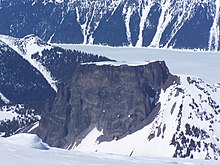



A ridge is a long, narrow, elevated geomorphologic landform, structural feature, or a combination of both separated from the surrounding terrain by steep sides. The sides of a ridge slope away from a narrow top, the crest or ridgecrest, with the terrain dropping down on either side. The crest, if narrow, is also called a ridgeline. Limitations on the dimensions of a ridge are lacking. Its height above the surrounding terrain can vary from less than a meter to hundreds of meters. A ridge can be either depositional, erosional, tectonic, or a combination of these in origin and can consist of either bedrock, loose sediment, lava, or ice depending on its origin. A ridge can occur as either an isolated, independent feature or part of a larger geomorphological and/or structural feature. Frequently, a ridge can be further subdivided into smaller geomorphic or structural elements.[1][2][3]
- ^ Nystuen, J.P. (ed.). Rules and recommendations for naming geological units in Norway, Norsk Geologisk Tidsskrift 69, supplement 2. Oslo, Norway. p. 111.
- ^ Huggett, R.J. (2011). Fundamentals of geomorphology (3rd ed.). New York, New York: Routledge. p. 516. ISBN 978-0203860083.
- ^ Neuendorf, K.K.E.; Mehl, J.P. Jr.; Jackson, J.A., eds. (2005). Glossary of Geology (5th ed.). Alexandria, Virginia: American Geological Institute. p. 554. ISBN 978-0922152896.